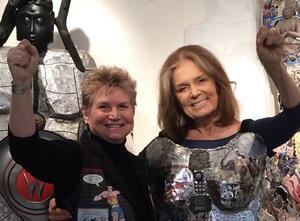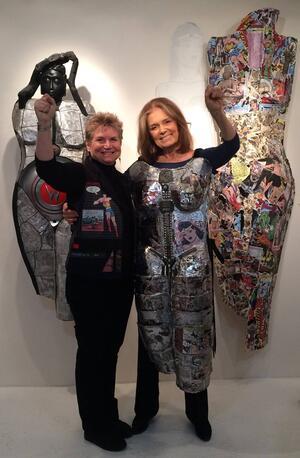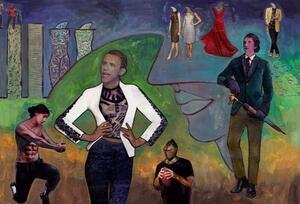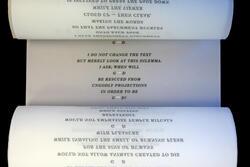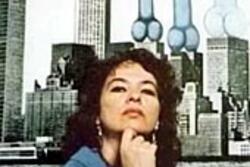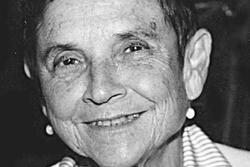Diving into the Wreck with Linda Stein
I was eighteen and a first-year in college when I first read Adrienne Rich’s “Diving into the Wreck.” In this poem, Rich writes:
“I put on the body-armor of black rubber...I came to explore the wreck...I came to see the damage
that was done/and the treasures that prevail...
the thing I came for/the wreck and not the story of the wreck
the thing itself and not the myth...
And I am here, the mermaid whose dark hair
streams black, the merman in his armored body
I am she: I am he”
As a young woman raised in a conservative community, my feminism was, at that point, only half-articulated. The idea that gender itself could be fluid, that someone could be both he and she and inhabit the space in between these two social constructs was entirely outside my realm of experience. And, yet, here was Rich placing her diver in a “black rubber suit” that allowed for the melding of male and female identities into one androgynous being that could submerge itself in a wholeness of self-expression. I became besotted with this narrative image, and with the idea that how you engage with the world could be altered, and made more honest, by the willingness to change your external self. I wound up writing my final paper on this rubber suit and the notion that one could put on, and experiment with, gender.
This image felt singular and powerful but it seemed the transformative “rubber suit” could only exist in Rich’s poetry.
Imagine my surprise when I encountered the equivalent of an androgynous rubber suit embodied in the sculpture of artist/activist Linda Stein. Unlike Rich’s suit, which is confined to the page, Stein’s art is tangible. In fact, some of these sculptures are wearable, as Gloria Steinem learned when she first visited the artist’s studio in Tribeca.
A New York-based artist, activist, educator, performer, and writer, Linda Stein starts a conversation, leading with art about the spectrum between masculinity and femininity. She focuses on authenticity and becoming an "everyday upstander" in the face of bullying and bigotry through her educational organization Have Art: Will Travel!
Stein has dedicated her life to exploring gender. With HAWT’s educational programs, including performances by local poets, actors, dancers, and songwriters, Stein inspires viewers to become protectors of “others” and upstanders against racism, ageism, classism, and trans/homophobia. In lectures at CUNY and in The Feminist Superhero, Stein has been the “bridge” between poets Adrienne Rich and Jayne Cortez. She is as fearless in her visual art as the poets are in their written words.
In Stein’s art, we see Eleanor Roosevelt rocking a bronzed six-pack, a voluptuous Barack Obama fearlessly addressing the nation in a feminine curves-hugging pantsuit, and Bella Abzug sporting both her signature hat and masculine arms.
The sculpture in this traveling exhibition, The Fluidity of Gender, is even more powerful. Participants can actually don a new avatar and take on another identity. When asked about her process of creating the wearable sculptures in her exhibition, Stein says:
As I create it, the sculpture becomes a kind of “foil” that protects me against my fears. I am making a defender and sentinel who will watch out for my safety. The form is androgynous and contains attributes along the continuum of masculinity and femininity. We all live between these binary constructions. If you look at “Mascu-Fem,” you will see breasts and more feminine attributes from the front and broader shoulders and more masculine traits from the back.
Stein’s artwork aims to empower women. In her second traveling exhibition, Holocaust Heroes: Fierce Females, the artist has chosen ten brave upstanders from the time of the Holocaust and created tapestries and sculpture about them. Her newest series, Displacement from Home–What to Leave, What to Take: Cabinets, Cupboards, Cases, and Closets, captures the chaos of displaced persons' experiences and the struggle in choosing what must be left behind. Stein’s activism is contagious as she travels around the country and abroad speaking at universities and museums. She offers her audience and participants a chance to expand their thinking about gender, identity, and authenticity. Her traveling exhibits are multi-layered, with books, videos, and educational curricula designed by international scholars.
When HAWT brought Stein’s The Fluidity of Gender exhibit to Helena, Montana, one participant, a staff member for the museum, was radically transformed in the process of hanging the art and reading about the artist. Stein recalls:
Paige Ferro stood up at the podium and said (for the first time in her life): Hello. I’m queer, and in the fourth row is my husband. You may think this is startling...First, I was a lesbian, then I was straight, and then I was bisexual and I wasn’t comfortable with any term. While this was happening, I fell in love with my husband and people came to me confused and asked how I could be marrying a man when I’m a lesbian. I knew, when I opened these crates and when I saw that these sculptures were about femininity and masculinity and the combining of the two, I couldn’t hide my feelings any longer from my neighbors. The word I want to use to identify myself is queer.
The Stein event provided this woman with a new way of opening up and entering the conversation around gender. It gave her the impetus to find the word she had been searching for. Linda Stein’s art creates a safe space for these conversations and allows her viewers and participants to put on their own “black rubber suits,” wade into the wreck, and engage with the “thing itself”––their personal authenticity.
See below for Stein's CUNY lecture on Adrienne Rich.


